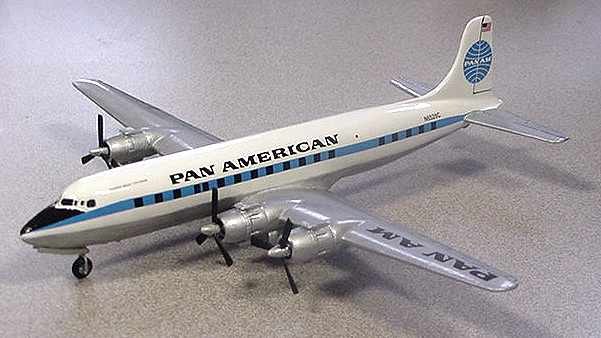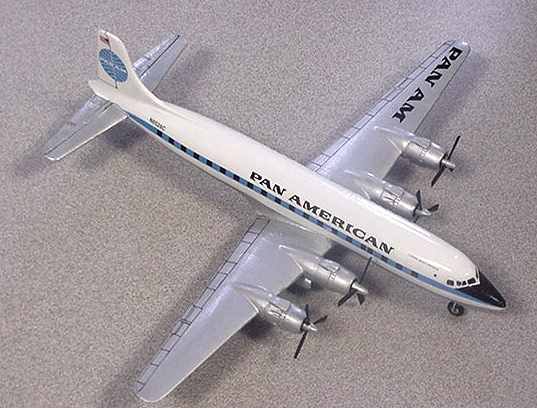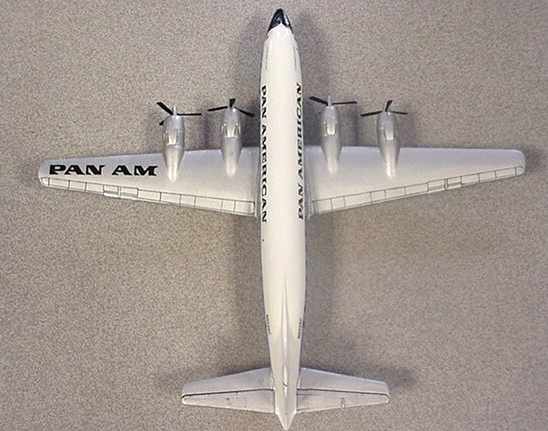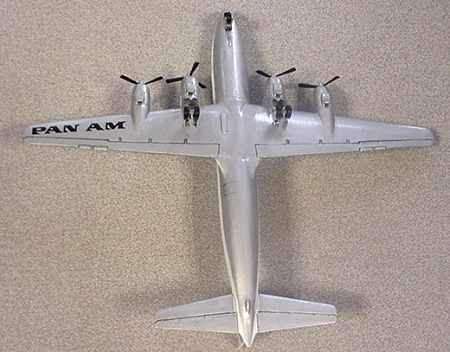
|
KIT: |
Minicraft 1/144 DC-6B |
|
KIT # |
14442 |
|
PRICE: |
$9.96 |
|
DECALS: |
Two Aircraft; Pan Am and SAS |
|
REVIEW & |
Danny Luey |
|
NOTES: |
Built OOB (Out of the Box) |

|
HISTORY |
 Based on the
DC-4 (C-54) design, the DC-6 was the first Douglas aircraft to be pressurized in
response to the demands of American Airlines and other airlines. Cabin pressure
was maintained at 5,000 feet while flying at 20,000 feet. With greater power
than the "A" version, the "B" versionís passenger capacity
increased from 58 to 89 and top speed from 350 mph to 380 mph. The DC-6B was a
great money maker for airlines with its economical operation and durability. Its
maximum payload range of over 3,100 miles made the DC-6B an intercontinental
carrier.
Based on the
DC-4 (C-54) design, the DC-6 was the first Douglas aircraft to be pressurized in
response to the demands of American Airlines and other airlines. Cabin pressure
was maintained at 5,000 feet while flying at 20,000 feet. With greater power
than the "A" version, the "B" versionís passenger capacity
increased from 58 to 89 and top speed from 350 mph to 380 mph. The DC-6B was a
great money maker for airlines with its economical operation and durability. Its
maximum payload range of over 3,100 miles made the DC-6B an intercontinental
carrier.
|
THE KIT |
The kit has three sprues with 63 injection molded plastic parts in light gray. The sprues are very bulky but the parts are well molded; be careful removing tiny parts like the antennas. The recessed engraving for control surfaces on the wings are deeper than the engraving for the rudder, tail wings, and passenger/cargo doors. A clear "windscreen" part is used for the cockpit area. Two decal options are provided: PanAm and Scandinavian Airways System (SAS).
|
CONSTRUCTION |
 Construction
is straight forward but modeling experience is necessary to achieve a reasonable
result. The kit instructions are pictorial with minimal text. Tweezers are
necessary for the small parts. Some deviations from the instructions include:
Construction
is straight forward but modeling experience is necessary to achieve a reasonable
result. The kit instructions are pictorial with minimal text. Tweezers are
necessary for the small parts. Some deviations from the instructions include:
The fuselage assembly requires sanding to smooth out the seam between fuselage halves. The clear windscreen will not fit perfectly atop the fuselage, filler will ease the transition. The wing assembly will not fit perfectly into the fusealge assembly. There is a 1/16 inch gap atop the wing and fuselage requiring filler. I couldnít cover the seam line below the fuselage even with sanding and filler.
|
PAINT & DECALS |
 There are no
panel lines on the fuselage to help locate the demarcation between the top white
and bottom natural metal. To make the demarcation, place a pencil on a paper pad
tall enough to mark the correct height when the assembled fuselage is on the
table. Keep the pencil fixed and move the airplane. Then mask along the pencil
line. Gunze silver was brush painted on the bottom of the fuselage, wings, and
tailplanes. The light gray panels on the wings for the PanAm were not painted:
its very difficult to mask parallel panels on the curved wings and the sample
model on the box did not show them. Many, many coats of Pactra flat white were
painted to the top side of the fuselage. The faintly engraved fuselage doors and
rudder are mostly lost under the white paint. Multiple coats of floor polish
provide a glossy finish for the decals. The instructions call for black
propellers but the sample model on the box were silver.
There are no
panel lines on the fuselage to help locate the demarcation between the top white
and bottom natural metal. To make the demarcation, place a pencil on a paper pad
tall enough to mark the correct height when the assembled fuselage is on the
table. Keep the pencil fixed and move the airplane. Then mask along the pencil
line. Gunze silver was brush painted on the bottom of the fuselage, wings, and
tailplanes. The light gray panels on the wings for the PanAm were not painted:
its very difficult to mask parallel panels on the curved wings and the sample
model on the box did not show them. Many, many coats of Pactra flat white were
painted to the top side of the fuselage. The faintly engraved fuselage doors and
rudder are mostly lost under the white paint. Multiple coats of floor polish
provide a glossy finish for the decals. The instructions call for black
propellers but the sample model on the box were silver.
Two complete sets of decals are provided: PanAm and Scandanavian Airways System (SAS). The decals are very thin and go on well. The fuselage decals are long and thin; use a wet toothpick to uncurl the decals as necessary. Multiple coats of floor polish provide a glossy overcoat over the decals. Note that the instructions show the PanAm logo on top of both wings; it makes more sense to show one on upper right and lower left as shown/implied on sample model on the box.
|
CONCLUSIONS |
It looks like a DC-6B. At 1/144 scale, that is sufficient for me and the friend who asked me to build the kit for him. A model builder with sharp eyes for details may find the propellers crude enough to replace them.
|
REFERENCES |
Box art and kit instructions.
If you would like your product reviewed fairly and quickly by a site that has over 1,500 visits a day, please contact me or see other details in the Note to Contributors.